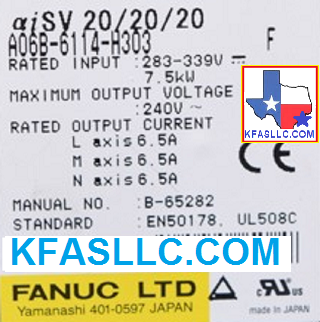A06B-6114-H303 SVM3-i 20/20/20-i

SAME DAY SHIPPING: IF ORDERED BY 3PM CENTRAL TIME
$2,000 ($450
Exchange Credit Available) ![]()
Repair/
Return Option Available At $1300.
Rated Input: 283-325VDC 7.5kW
Rated Output Current:
L axis 6.5 A
M axis 6.5 A
N axis 6.5 A
Understanding Cooling Fan Alarms
Internal Fan: A90L-0001-0510
External: None
A06B-6114-H303 Alarms Meaning and action to be taken
Alarm Meaning
1
Internal Fan Stopped (FAL)
2
Low control power voltage (LV5V)
5
Low DC link voltage (LVDC)
6
Inverter Overheat Alarm
"6" or "b"
F
External Cooling Fan Stop
P
Communication Error
8
L-axis over-current (HCL)
9
M-axis over-current (HCM)
A
N-axis over-current (HCN)
b L
& M-axis over-current Alarm
"6" or "b"
C M
& N-axis over-current
d L
& N-axis over-current
E
L, M, N -axis over-current
8.
L-axis IPM alarm (IPML)
9.
M-axis IPM alarm (IPMM)
A.
N-axis IPM alarm (IPMN)
b. L
& M-axis IPM alarm
C. M
& N-axis IPM alarm
d. L
& N-axis IPM alarm
E.
L, M, N-axis IPM alarm
L FSSB
Disconnect COP10A
U FSSB
Disconnect COP10B
Related Part NumbersKFASLLC
kfasllc.com
A16B-2203-0698
A20B-2100-0742
A20B-2101-0042
A90L-0001-0510
A90L-0001-0385
Fanuc Alpha Servo A06B-6114-H303 features
・high power and high acceleration due to optimum winding design and
effective cooling structure.
・Increased torque at low speed range
・Super High precision and high resolution Alpha-iA pulse coder feedback
(16,000,000 pulses/rev)
・Available with both 200V input and 400V input
・Compact size with latest intelligent Power Module (IPM) technology.
・Utilize power source regeneration technology to return regeneration
energy of the motor to a power source.
Compared with the resistor regeneration, power consumption is largely reduced.
A06B-6114-H303 is used with αiF 1/5000, αiF 2/5000, αiS 2/5000, αiS 2/6000, αiS 4/5000.
Competitive pricing
Fast, reliable delivery
12 Month Warranty included
Trusted source for authentic FANUC parts
Expert support from experienced CNC technicians